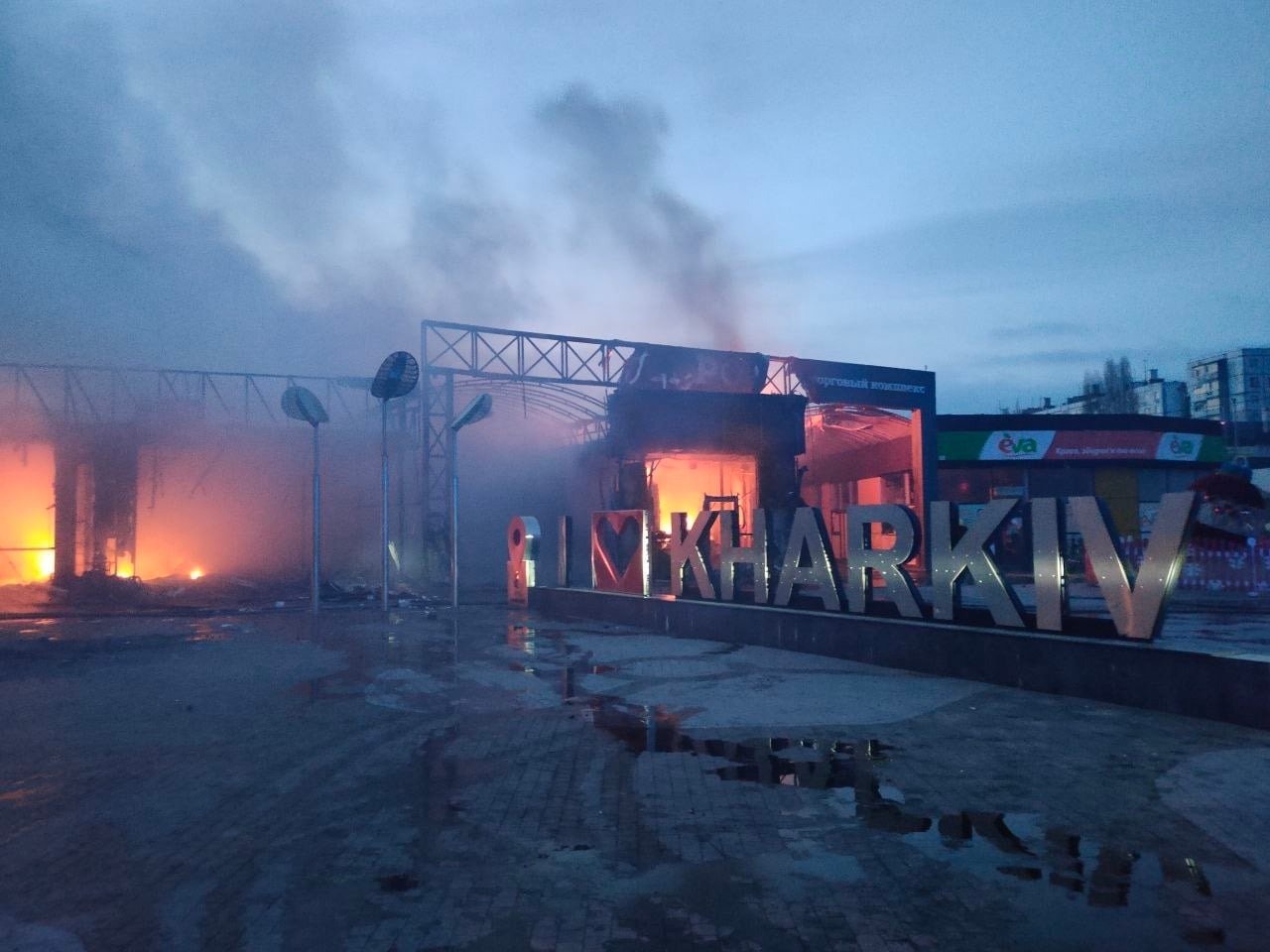By Serhiy Petrov
The intensity of muscovite shelling was relatively low today, but the attacks were more numerous than on Wednesday. The shelling mostly aimed at the suburbs and areas already targeted before.
The intensity of the shelling of Kharkiv wasn’t too high, about average of the intensity we saw in mid-April. The shelling varied in quantity and intensity in different areas. Again, the muscovites got active in the morning. The intensity mostly decreased in the daytime. Sometimes it was fairly quiet. But in the evening there was a flareup of activity again. They fired on various districts of Saltivka, Selyshche Zhukovskoho, Pyatykhatky, the Kharkiv Tractor Plant neighborhood, as well as Oleksiyivka and Novi Budynky. A shell hit a car directly in Selyshche Zhukovskoho. The car burned down, and the two people inside were killed. Another two markets were burned down in the city as a result of shelling on Wednesday night.

Out in the suburbs, the muscovites were shelling Derhachi, settlements of the Derhachi Hromada, and in the Chuhuiv direction. The village Udy, of Zolochiv Hromada, was also shelled by ruscist troops, and as a result six houses were destroyed and more than 30 damaged. Fortunately, no-one was injured, because residents immediately hid in basements or cellars just as the shelling started.
As before, local authorities in Kharkiv are urging people not to leave their homes unnessasarily.
Mayor Terekhov also called on the citizens to evacuate from the areas that are under constant shelling. In my opinion, it should have been announced much earlier. There are still some people refusing to leave the areas that have been shelled the most. What to do about them is a difficult question, but forced evacuation may be necessary, because volunteers or police officers who bring them food have to travel to dangerous areas and risk their lives.
Flowers are planted in the center of Kharkiv, which contrasts with what is happening in the areas that are under attack. Even traffic flow can be a clear indicator of whether an area is relatively safe or dangerous. In general, no place in Kharkiv is completely safe, because, as we’ve seen, muscovites can fire at any area at any time.
The public utility workers in the city are unbelievable, using any quiet time to clean and repair supply systems. Of course, locals who have stayed in Kharkiv also help them with the cleaning. The public utility services of Kharkiv will go down in history as a bastion of its defense during the war. They have provided the city with the strength and ability to successfully defend itself.
However, things are very different in the region. Difficult battles continue in the Izium area and in the Barvinkove direction. Our military shot down two planes in this area, Su-34 and Su-35, as well as a drone, all in one day.
People in occupied territories are under a blockade, not allowed to go anywhere. Volunteers who were traveling from Shevchenkove and the territory controlled by the Ukrainian government got shot and killed. The local population is held hostage by the muscovites. They are offered to relocate to moscovia as the only way out or be forcibly deported to Siberia or somewhere else, with a two-year ban from leaving moscovia. If you are lucky, you can try to get to the border with Estonia and Latvia (even without an international passport) and escape to safety.
Information about the head of the occupier administration of Lyptsi (north of Kharkiv) came to light. His name is Vadym Kudikov. He was a representative on the Lyptsi village council. No, he is not from “opezdezhe” (the Opposition Platform—For Live party). He is from the Servant of the People party. Moreover, he was an assistant to former chairman of the Kharkiv regional council (from the same party) Artur Tovmasyan. It would be interesting to ask what the party leadership thinks about this. Because the questions about people suspected of treason are always timely. And, for the cherry on the cake, Kudikov happened to have been constantly accused of dishonest farming business practices, particularly, rading. Add the fact that his brother works for the police in Lyptsi, and the picture becomes more complete. This collaborator showed the occupiers the best ways to move around the hromada and collected information on Anti Terrorist Operation and Joint Forces Operation soldiers and their families. A criminal case of treason has already been opened against him.
The battles for Kreminna, Rubizhne, and Popasna also continue. For the third time (!!!) the muscovites have announced that they have established control over Rubizhne, but that’s still not the case.
The Mariupol story is being repeated to some extent. Additionally, they have to keep their population’s spirits up with constant victories. They forget which cities they took and which they haven’t anyway. Fighting continues in the Avdiivka area and behind Maryinka, as well as near Vuhledar and Velyka Novosilka in the Donetsk region. Muscovites are trying to attack Huliaipole in the Zaporozhzhya region.
In Mariupol, our defenders continue to hold the line. However, the lack of significant progress in advancing on all sections of the Donbass front has forced “khlo” (translator: pejorative for “Putin”) to announce once more the capture of Mariupol. Even though there’s still a “small group” of Ukrainian servicemen there, the command was given to block them but not to storm. The storming of Azovstal has cost at least a few thousand ruscist corpses. At the end, a significant part of the troops were relocated to other parts of the front. The haste of these actions (the full capture of Mariupol was being prepared for Easter) means that the offensive is not going exactly according to the plan and the occupiers simply do not have enough forces and resources. The humanitarian corridor from Mariupol and Zaporizhzhya did not work.
In Mangush, near Mariupol, muscovites built a mass grave for city residents, over 300 meters long. It was estimated that between 4,000 and 9,000 people may be buried there.
The muscovites launch missile strikes on Mykolayiv and Dnipropetrovsk regions. In particular, the railway near Novomoskovsk was damaged. By the way, residents of this city undertook an initiative to rename it and bring back its ancient name Samar (a city on the banks of the Samara River).
In Yakymivka village (center of the Yakymivka Hromada) of the Melitopol district in the Zaporizhzhya region, temporarily occupied by muscovites, an unknown patriot removed the tricolor rag from a flagpole. Honor and praise to him!
In Kherson, the ruscists are preparing a pseudo referendum to proclaim the so-called “People’s Republic of Kherson,” which is scheduled for May 1 (another symbolic date). After that, they plan to conduct a “census,” and it is already forbidden to move between settlements in rural areas of the occupied part of the Kherson region. Also, the muscovites have already announced forced mobilization of men, citizens of Ukraine, to join the occupying army before the “referendum.”
Decolonization and completion of decommunization are ongoing in Ukraine. Monuments to muscovite occupation forces are being dismantled and the streets associated with muscovite toponyms, cultural figures, politicians, and the military figures are being renamed. For example, a monument to Zoya Kosmodemyanska was demolished in Chernihiv, and some of the streets in Dnipro were renamed. Thus, Khabarovsk Street was renamed to Saltivska Street. As a resident of Saltivka (at least with a residence permit there), I thank you very much!
Estonia became the first country in the world to recognize the muscovite invasion and actions against the population in Ukraine as genocide of the Ukrainian population. A similar decision was also made in Latvia.
Things are restless in moscovia. In Tver, the research institute of the Ministry of Defense of Moscow, engaged in the development of air defense control systems and ballistic missiles, burned down. One person was killed and 30 injured.
I wonder if there was another short circuit? There was also a fire at the Dmitrovsky chemical plant in the city of Kineshma of the Ivanovo region, which makes industrial solvents. Looks like there was a fiery Thursday in moscovia, maybe to cleanse the filth…
There will be no Darwin Award nomination today, because there were no funny incidents. And I believe that the new day will bring new nominees, or you can always offer options to me in the comments.
Let us believe in our army! Let us help volunteers, doctors, rescuers, and public utility workers. Let us believe in each other and bring our victory closer!







